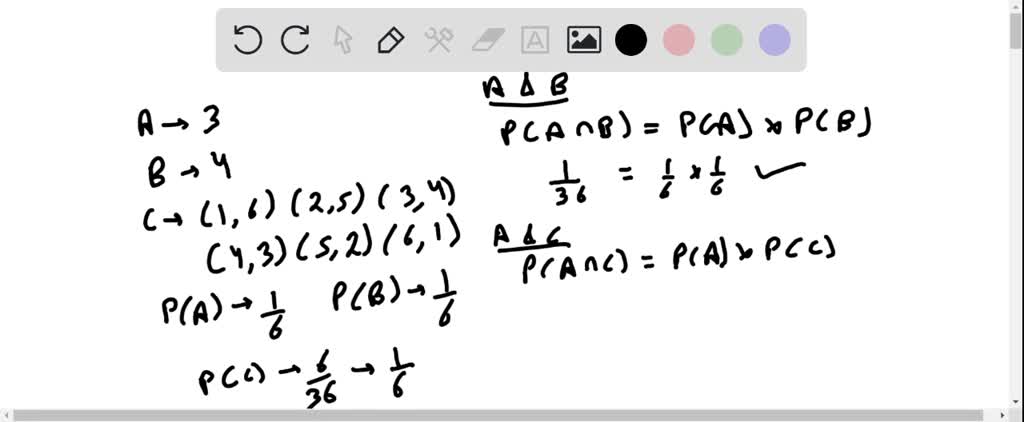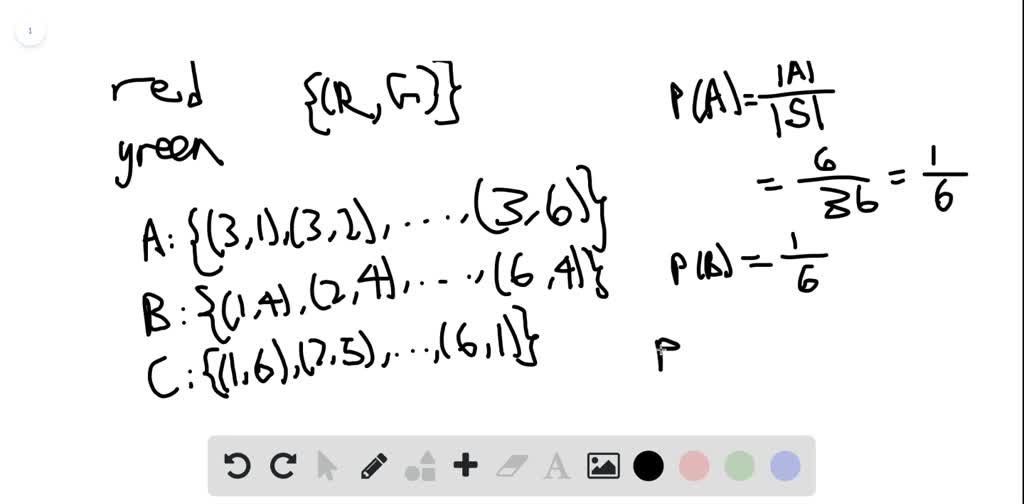Let A be the event that the red die shows 3 dots B be the event that the green die shows 4 dots and C be the event that the total number of dots showing on the two dice is 7. Write your answer as a fraction.

Solved 82 Consider Independently Rolling Two Fair Dice One Chegg Com
You dont need to simplify the fraction.

. So are they Independent question mark. The two dice is 7. The use of a tree diagram demonstrates that there are 6 x 6 36 possible outcomes from rolling two dice.
The results of fair rolls are independent so we can use the simple version of the rule for conjunctions of independent events. When dealing with independent events we use the multiplication rule. Consider independently rolling two fair dice one red and the other green.
Are these events pairwise independent ie are A and B independent events are A and C. If the two dice are fair and independent each possibility ab is equally likely. Let A be the event that the red die shows 3 dots B be the event that the green die shows 4 dots and C be the event that the total number of dots showing on the two dice is 7.
Let A be the event that the red die shows 3 dots B be the event that the green die shows 4 dots and C be the event that the total number of dots showing on the two dice is 7. Probability and Statistics for Engineering and the Sciences Loose-Leaf Version 9th Edition Edit edition Solutions for Chapter 2 Problem 82E. Consider the following eventsA rolling a number less than 6 on the first die B rolling a sum of 8 or moreClick here to see the sample space.
Let A be the event that the red die shows 3 dots B be the event that the green die shows 4 dots and C be the event that the total number of dots showing on the two dice is. The total number of outcomes 36. Total number of outcomes 36.
Let A be the event that the red die shows. Two fair dice one red and the other green are rolled independently. Let A B C be the events of getting a sum of 2 a sum of 3 and a sum of 4 respectively.
3 dots B be the event that the green die shows 4 dots and. One roll has no effect on the other. Let A be theevent that the red dieshows 3 dots B be the event that the green die shows 4 dots and C be theevent that the total numberof dots showing on the two dice is 7.
Consider the sample space in case of two dice are thrown. Two dice are rolled. Math Statistics QA Library Consider rolling two fair dice.
Consider independently rolling two fair dice one red and the other green. Let A be the event that the red die shows 3 dots B be the event that the green die shows 4 dots and C be the event that the total number of dots showing on the two dice is 7. For N50 p50097037 or 97 chance to have two people with the same birthday.
So the question first of all for 18 says are the outcomes on the dice independent. Let A be the event that the red die shows. Let A denote the event that the red die shows 3 and B denote the event that the green die shows 4 dots and C denote the event that the total number of dots showing on the two dice is 7.
Consider independently rolling two fair dice one red and the other green. The total number of outcomes of the two dices is 36. Let A be the event that the red die shows 3 dots B be the event that the green die shows 4 dots and C be the event that the total number of dots showing on the two dice is 7.
In case of two dice we always get a pair of numbers like 16 or 36 it is expected that each single outcome of first dice will be associated with 6 possible outcomes namely 123456 so the sample space should contain 6x636 elements. This is because rolling one die is independent of rolling a second one. Consider independently rolling two fair dice one red and.
Consider independently rolling two fair dice one red and the other green. 1 Two fair dice are rolled. Find PA and B.
Consider independently rolling two fair dice one red and the other green. Let A be the event that the red die shows 3 dots B be the event that the green die shows 4 dots and C be the event that the total number of dots showing on the two dice is 7. C be the event that the total number of dots showing on.
Clearly we have A. These probabilities are in general much larger than most peoples intuition would have guessed. Find PA or B.
What is the probability p that at least one die come up a 3. So the probability of an event number of favorable outcomes total number of outcomes. Probability 16 Let A be the event that the sum of the two dice is 5 Let B be the event that the green die is either a 3 or 4 Then we want P A B which we calculate using the conditional probability formula.
So only 1 outcome. A Are theseevents pairwise independent ie are A and B independent events are A and. Are these events pairwise independent ie are A and B independent events are A and C.
That is X 123456 and Y 123456. Then show that i A is a simple event ii B and C are compound events iii A and B are mutually exclusive Solution. 11 12 13 14 15 16.
I Number of favorable outcomes of the sum of 2 is 11. Consider independently rolling two fair dice one red and. Considerindependently rolling two fair dice one red and the other green.
Using this rule the probability of not getting 7 in any of three fair rolls of two dice is 56 x 56 x 56 563 125216. Rolling two fair dice more than doubles the difficulty of calculating probabilities. Consider independently rolling two fair dice one red and the other green.
Third we use the rule for conjunctions to calculate the probability of not rolling 7 in any of three consecutive fair rolls of two dice. Assume that the die is fair ie. We can do this two ways.
The two dice is 7. It is easy to check from the joint probability distribution that throwing of two dices are statistically independent. Because E is composed of 4 such distinct singleton events P E436 19.
And the answer is yes because one role does not effect the outcome of the other. Two dice are rolled at a time. I The straightforward way is as follows.
C be the event that the total number of dots showing on. Because there are 36 possibilities in all and the sum of their probabilities must equal 1 each singleton event ab is assigned probability equal to 136. Consider independently rolling two fair dice one red and the other green.
Are these events pairwise independent ie are A and B independent events are A and C independent and are B and C. Are these events pairwise independent. P A B PA nn B PB Consider first PA nn B which we can calculate using PA nn B nA nn B nT Where nT is the total number of possible.
Each of the sides come up with equal probability of frac16. Consider independently rolling two fair dice one red and the other green. Let A be the event that the red die shows 3 dots B be the event that the green die shows 4 dots and C be the event that the total number of dots showing on the two dice is 7.
Roll the red role when you rolled eyes or networks the same two if you are flipping coins to two different coins. 3 dots B be the event that the green die shows 4 dots and.

Solved 6 12 Points Devorestat9 2 E 082 Consider Chegg Com

Solved Consider Independently Rolling Two Fair Dice One Red And The Other Green Let A Be The Event That The Red Die Shows 3 Dots B Be The Event That The Green Die

Solved Consider Independently Rolling Two Fair Dice One Red And The Other Green Let A Be The Event That The Red Die Shows 3 Dots B Be The Event That The Green Die

Solved Consider Independently Rolling Two Fair Dice One Red Chegg Com
0 Comments